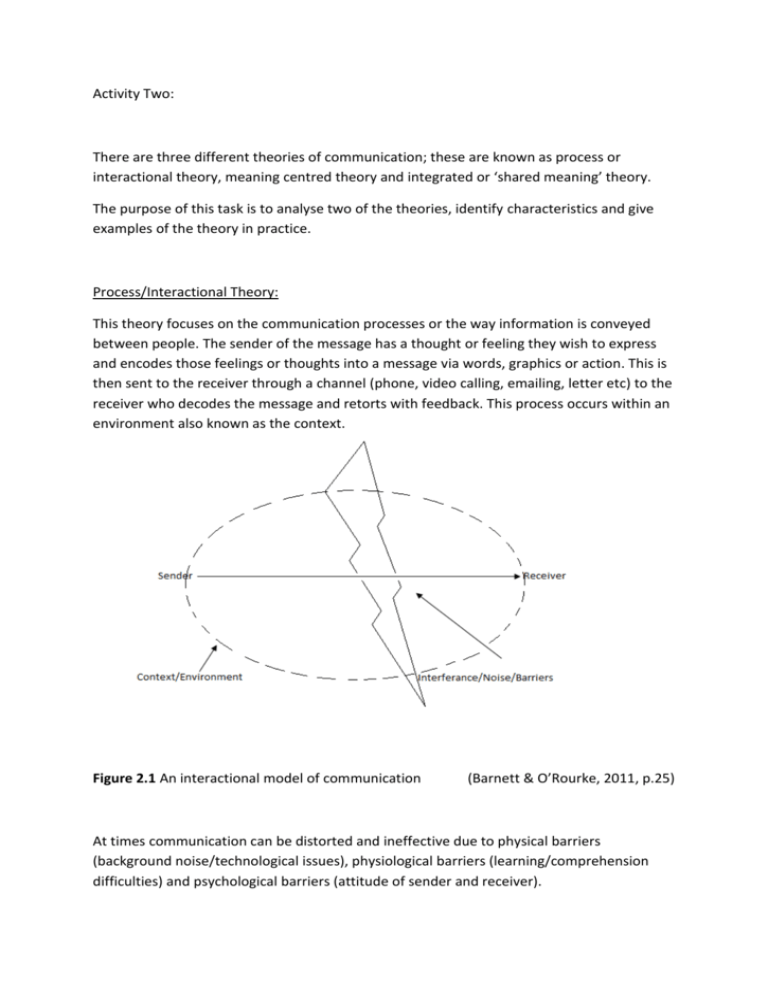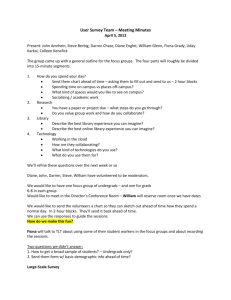Activity 2 and 3
advertisement

Activity Two: There are three different theories of communication; these are known as process or interactional theory, meaning centred theory and integrated or ‘shared meaning’ theory. The purpose of this task is to analyse two of the theories, identify characteristics and give examples of the theory in practice. Process/Interactional Theory: This theory focuses on the communication processes or the way information is conveyed between people. The sender of the message has a thought or feeling they wish to express and encodes those feelings or thoughts into a message via words, graphics or action. This is then sent to the receiver through a channel (phone, video calling, emailing, letter etc) to the receiver who decodes the message and retorts with feedback. This process occurs within an environment also known as the context. Figure 2.1 An interactional model of communication (Barnett & O’Rourke, 2011, p.25) At times communication can be distorted and ineffective due to physical barriers (background noise/technological issues), physiological barriers (learning/comprehension difficulties) and psychological barriers (attitude of sender and receiver). Integrated/’Shared Meaning’ Theory: This theory focuses on the process of the communication, as well as the outcome. It attempts to construct shared meaning of the message from both the sender and the receiver. Messages are encoded by the sender, who conveys the messages within a context. Ideally this process will result in ‘shared meaning’, where the receiver understands the message the way it is intended by the sender with no other influences interfering with the transmission. Activity Three: Characteristic Sender Receiver Channel Message Encoding Decoding Feedback Context Answer Fiona Pete Email Non Verbal Fiona – “Hi Pete, Can I get some information from you? Are you in a meeting at the moment? Fiona” Pete – “No. P” “No. P” – very poor feedback Office/work environment One of the barriers in the scenario was that Fiona and Pete were not very specific or precise in regards to the content of their emails to each other. Fiona asked two questions in her message to Pete which should have been avoided as it is difficult to answer too many questions at once. What she should have said in her email was “Hi Pete, I need to get some information from you regarding the project I am working on. Are you available for us to meet and discuss this? Thanks, Fiona”. This would have made it easier for Pete to respond. Pete also needed to be more specific in his response to Fiona. He needed to elaborate on his answer and make it clear which question he was answering. If he was telling Fiona he would not help her he should have said “Sorry Fiona, I cannot help you with your project. Pete”. He could then have gone on to let her know somebody else who may have been of help. If he was answering her question about not being in a meeting, he could have said “Hi Fiona, I am not in a meeting at the moment. Come over to my office and we can discuss the matter further. Pete”. Due to the miscommunication from both parties, Fiona in now worried that she will not complete her project by the deadline. Work cited: (Barnett, S, & O’Rourke, S. (2011) Communication organisation and innovation. Auckland, New Zealand: Pearson)








